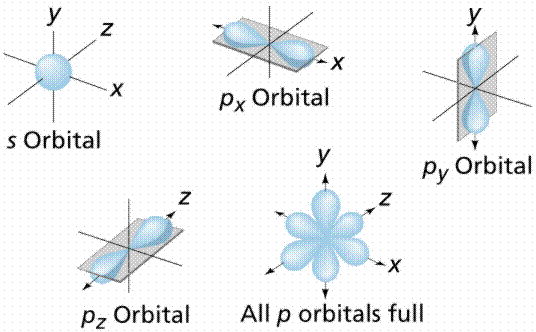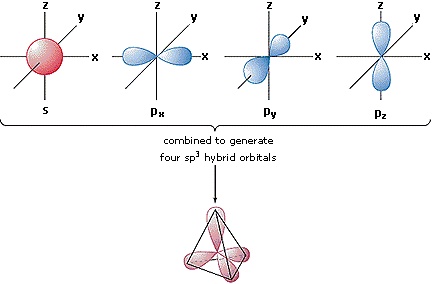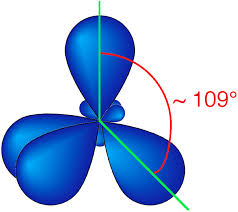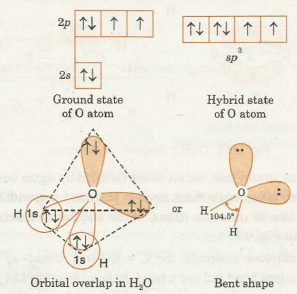If the models we use to teach the structure are antiquated and brain-dead, with what do we replace them? The answer is simple: we replace them with an age-appropriate description of quantum mechanics, the counterintuitive theory that, while unquestionably incomplete, still gives exact and correct answers to the physical problems it addresses. You can’t do without it. Modern electronic technology is incomprehensible without modern quantum mechanics, notwithstanding its weird wave/particle duality (the electron must be viewed as both a particle and a wave, simultaneously).
I’ve heard all sorts of objections to this proposal, and none of them are convincing. Is quantum mechanics difficult? It sure is. Richard Feynman, one of the greatest physicists of the 20th Century, insisted that no-one really understood it, including him. Its mathematics along are maddeningly complex. Even for as simple a project as getting the functions that generate the orbitals on an atom (hang on….we’ll get there shortly!), you probably have to be a graduate student in chemistry or physics with a lot more math than most undergraduate physics and chemistry students have.
But since when did we decide that students have to understand a subject at its most profound level before we teach it to them? Take the reading lists of any 6-12 grade English class, or the topics that are covered in history, and you’ll see that there’s no chance of a complete understanding the first time out. Just because Shakespeare takes a lifetime of experience to appreciate fully does not mean that middle-school students shouldn’t be reading (and, frankly, struggling) with his language, or that history students can explore complex subjects like human slavery. To be sure, they will understand it in more depth when they study it later, but that has never prevented early exposure of a topic to students, absent compelling developmental reasons.
Aside: Math is one of the subjects in which developmental reasons (“math maturity”) require careful consideration. For example, many teachers believe that a classic algebra 1 course should never be taught to students below the 8th grade.
A good comparison can be made to geology. The California standards for earth science in 6th grade used to require that students learn the details about earthquake. I have taught the qualitative mechanics of earthquakes to 6th graders, and have had them tear apart the inaccuracies of a film like San Andreas. But to understand the full mechanics of earthquakes, you practically have to wait until you’re well into your Ph.D program in geology. Be thorough and complete is not necessarily necessary, although one hopes that the simplifications aren’t misleading like the Lewis dot diagrams are.
Before we begin, there are four basic things you need to accept. You may not entirely understand them or agree with them. If you follow the argument through to its end, I hope you’ll agree that the predictive power of these assumptions is broad and astonishing. Here they are:
- If you (can!) do the math from the quantum mechanics equations, it turns out that the electrons are packed into different levels, each successive one farther from the nucleus. The farther out you go, the more energy it takes to get electrons there. These energy levels are sometimes called “shells.” If you’ve studied chemistry and remember the Periodic Table, the rows of the table correspond to the different energy levels. There are a maximum number of electrons you can pack into each level: 2 in level 1, 6 in levels 2 and 3, 16 in levels 4 and 5, and so on. (The details aren’t important to us now, because we’re only going to be looking at the elements in row 2.)
- Within each energy level, electrons in an atom are contained in regions of space called orbitals. These areas don’t look anything like the orbital path of a planet around a star. They are simply areas of space where the electrons can reside. Each orbital can hold a maximum of 2 electrons.
- Chemical bonds are formed when orbitals from different atoms overlap. Except for some specialized “bonds” like hydrogen bonds (wait till the next installment!), a bond has a maximum of 2 electrons in the overlapping orbitals. The bigger the overlap between the orbitals, the stronger the bond.
- If we can minimize energy by electrical repulsion between like charges, it’s a good thing. A seriously good thing.
With these assumptions in mind, here’s how I’d present this to an 8th-grade physical science class. We have quantum mechanics, an elegant theory that attempts to describe, if not explain, how small bits of matter like electrons and energy in the form of light can behave both like hard particles and like waves. It’s a wonderful and complex theory, and you have to have quite a bit of math and physics and the ability to do hellishly complex math to get the results.
But when you do get the results, they’re like this. It turns out that atoms have levels or “shells” that hold electrons. These levels are not at all like the orbits of planets; they are simply areas of space where the electrons will hang around. As you increase the number of electrons, they go into different parts of the shells. The higher the shell, the more energy it takes to put an electron there, and the more energy that electron has.
When you do the math, the shells (sometimes called “energy levels”) break down into different components called orbitals. Each orbital can hold two electrons. The first two orbits are the “s orbital” and the “p orbital”. Each energy level has one s and three p orbitals. The s orbitals on a given energy level are slightly lower in energy than the p orbitals. The three p orbitals are all perpendicular to each other. If you graph the math, the orbitals look like this:
Because the s orbitals are slightly lower in energy than the p orbitals, they fill up first. As you add protons in the nucleus, you add electrons to balance the electric charge to keep the atom electrically neutral. If the s orbital is full, you can start filling the p orbitals. All you have to remember that opposite charges attract and like charges repel. Each orbital can hold 2 electrons, but it’s lower energy if you partially fill each orbital: one each into each p orbital, and then filling in the second electron, one at a time, to each orbital, until you have a maximum of 6 electrons.
Chemistry is all about how these electrons are organized on the highest energy shell. Their orientation will determine how they bond and how they react with other elements.
Thus far we aren’t a lot different from the Lewis dot diagram. True, we have two different types of orbitals at the same energy level, but we still have the problem that the p-orbitals are all 90 degrees apart from each other whereas the experimental angle between the two hydrogens would be 104.5 degrees.
Fortunately, there is a solution. Remember that like charges repel. If we have pairs of electrons in orbitals that are at 90 degrees to each other, we can get give the atom lower energy (which is always what we’re looking for) if we can increase the angle. But how?
What I’m about to tell you may sound like magic, but it’s really only a matter of taking the “average” of the 4 orbitals we have on the given energy level. If we add them all together, we can get 4 orbitals that are shaped rather differently from a single s orbital and 3 p’s. We have three desirable results. First, the resulting orbitals are somewhat bigger than the original p orbitals. The bigger the orbital, the stronger the bond, and the more stable the molecule. Second, we now have the 4 orbitals in a very different and much more favorable energy configuration. The angle between the orbitals is now 109.5 degrees instead of 90 degrees, significantly reducing the repulsion between the electrons and therefore lowing the energy. The orbitals are oriented from the center of a tetrahedron to the apexes, and looks something like this:
Third, we now have some understanding of why the periodic table is shaped the way that it is. In the first 3 rows, the first two columns on the left correspond to the s orbitals, and the 6 columns on the left correspond to the filling of the p orbitals:
(You can also explain the rest of the table, but I’ll defer that for now unless I hear a groundswell of demand. The point is simply that by applying quantum theory, things that are otherwise inexplicable and magical become the easily-understood consequences of atomic structure.)
The geometry of the tetrahedron is often hard to see for students not accustomed to isometric tw0-dimensional drawings. When I teach this, I always have 3-D models to demonstrate. However, the following diagrams are pretty good illustrations of what’s going on (the one on the right is for methane, not water, but the geometry is similar if not the length of the sides of the tetrahedron):
If we are looking at oxygen, the four apexes of the tetrahedron represent the orbitals, and the center is the nucleus.
We’re not quite there, but almost! If we now fill the hybridized orbitals, we get two orbitals that are completely filled, and two orbitals that have only one electron in them. 2 hydrogen atoms can now overlap with these orbitals, and we will get something that look like this:
Don’t worry about the 2s and 2p diagrams at the top, although they’re useful to know and well within the grasp of 8th graders. Look at the diagram on the lower left. Two hydrogens have come in and contributed their electron to the two sp3 orbitals from the oxygen, and we have two lone electron pairs in the remaining two orbitals. We’re still not at 104.5 degrees, but we’re close.
Aside: note that there’s no hybridization of the 1s orbital on the hydrogens. This is because, according to the theory, you only have a single type of orbital on the first energy level (a 1s orbital) so there’s nothing to hybridize. The energy cost of hybridizing up and down the energy levels is such that you can’t combine, say, a 1s orbital with a 2p orbital. In atoms, the electrons have some limitations on where they can go and with whom.
This is what happens: it turns out that we can get even lower overall energy configuration of water if we let the two lone electron pairs repel each other and create an angle slightly larger than 109.4 degrees. As they do this, they necessarily squeeze the remaining two orbitals closer together. The happy medium….not too hot, not too cold, not to hard, not too soft….is when the angle between the two hydrogens reduces about 4.5 degrees from about 109 degrees to 104.5.
Now we have a theory that explains exactly why the water molecule has the shape that it has. There’s no mystery about the 104.5 degree angle; we can explain it exactly (a high-school chemistry class with good math skills could probably do the electrostatic calculations with some scaffolding support from the teacher). Further, as we’ll see in the next installment, it explains why water is such an amazing and universal (almost) solvent. Understanding this structure of water also explains why water has such high heat capacity, why ice is less dense than liquid water, and why water has such high surface tension and lets us compare water to comparable molecules (methane [CH₄], ammonia [NH₃] and hydrofluoric acid [HF]) and explain why they have such different chemical properties even though they are structurally very similar. We explore this and more in coming episodes. Stay tuned.






